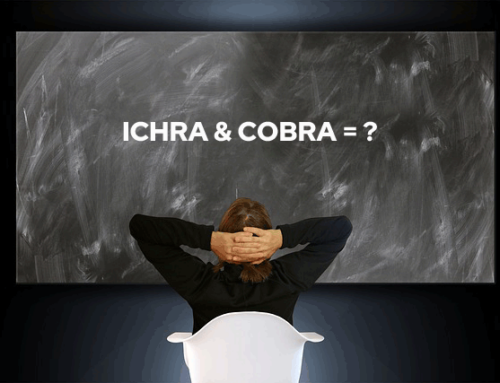One of the great things about the Individual Coverage Health Reimbursement Arrangement (ICHRA) is that employers of all sizes can utilize this program. Both large and small employers can take advantage of this new way of offering employees a great tax-free benefit. But how do we distinguish between large and small employers?
According to the Affordable Care Act (ACA), small employers have less than 50 employees. You might assume a large employer has 50 employees. But this is where it gets tricky. The Affordable Care Act defines employers with 50 or more full-time equivalent employees as Applicable Large Employers, also referred to as an ALE.
Applicable Large Employers and Mandates
An ALE is subject to some additional mandates, such as affordability, minimum essential coverage, and minimum value when it comes to healthcare for their employees. Both minimum essential coverage and minimum value are fundamentals embedded in ACA Individual Health Insurance plans covered under an ICHRA plan. But “the affordability mandate” for an ALE is not.
The affordability mandate is the calculation that ALEs must conduct to prevent potential IRS penalties in offering an Affordable ICHRA Plan. This affordability mandate is not exclusive to employers providing traditional group coverage; it also extends to those offering an ICHRA.
2025 Affordability Changes
The IRS has recently implemented changes to what is considered affordable, impacting the extent of contributions employers must make toward the health coverage of their eligible employees.
For the plan to be considered affordable, an employee’s cost cannot exceed more than 9.02% of an employee’s household income for 2025. This is up from 8.39% for 2024. Each year the threshold changes and the employer must recalculate affordability.
ALE Affordability Safe Harbors
Large employers do not typically know an employee’s household income so “safe harbors” have been put in place as benchmarks enabling employers to determine affordability for their plans. ALEs will be able to utilize either Federal Poverty Level (FPL), Rate of Pay or W-2 safe harbors.
According to the ruling, health insurance for an employee is considered affordable if the cost does not exceed 9.02% of the employee’s household income. The benchmark for this calculation is the premium of the lowest-cost silver plan available on the local exchange, with the employer’s ICHRA contributions subtracted from the premium.
In practical terms, this implies that the monthly premium for the lowest-cost silver plan, after deducting the ICHRA monthly allowance provided by the employer, should not surpass 9.02% of the employee’s household income for that month. Meeting this requirement classifies the ICHRA as affordable.
Calculating Employer Contributions for ALEs
Follow these three steps to arrive at the contribution amount for Applicable Large Employers.
Step 1: Choose a Safe Harbor
There are three Safe Harbors in Affordability that can be used since not all employers know the total household income of each employee. ALE employers can utilize one of the following safe harbors per ICHRA class of employee.
- Federal Poverty Level (FPL) Safe Harbor 2025– Each year, Department of Health and Human Services (HHS) publishes the annual FPL. For the 2024 tax year, the mainland FPL for a household size of one at $15,060 is used. That would mean that $113.20 is the max contribution an employee can make to the lowest cost silver plan. For employees working in Alaska, the rate is $141.38 per month, while the rate in Hawaii is $130.11 per month. ALEs may use any FPL guidelines in effect within six months before the first day of the plan year, providing employers ample time to calculate employee contributions in advance of the plan’s open enrollment period.,
- Rate of Pay Safe Harbor 2025– To consider coverage as affordable, the employee should not be required to pay more than 9.02%% of their monthly rate of pay when coverage begins.
With Hourly Employees the monthly rate of pay is calculated using 130 hours, regardless of the actual hours worked. For non-hourly employees, affordability is based on their monthly salary at the beginning of the coverage period.
Hourly employee example formula: $18/hr x 130 hours x 9.02% = maximum monthly employee contribution of $211.06
Salary employee example formula: $3,000 monthly salary x 9.02% = maximum monthly employee contribution of $270.60
- W-2 Safe Harbor 2025 – Affordability is found by use of an employee’s gross income for the W-2 Box 1.
Example 1: According to Dominic’s W-2 he received $45,000 gross income in box 1. The formula is ($45,000 x .0902)/12 = $338.25 maximum monthly employee contribution
Example 2: Mary was hired on February 15th and was offered coverage after her waiting period on May 1st. Her W-2 wages according to box 1 are $38,000. In this situation, we can modify the W-2 wages used for the affordability calculation. This adjustment is necessary because Mary wasn’t employed for the entire year, and there was a waiting period before she was eligible for coverage.
Formula: W-2 wages * (calendar months offered coverage / months of employment) = $38,000 x (8/11) = $27,740
This gives us the Adjusted W-2 wages $27,740 for the 8 months Mary is offered coverage. The final formula is (Adjusted wages x .0902)/calendar months offered coverage = maximum monthly employee contribution ($27,740 x .0902)/8 = $312.76 max employee contribution.
Step 2: Find the Affordable Benchmark Plan
Once you have calculated the max employee contribution amount by utilizing one of the three safe harbors you will now need to calculate the employer’s contribution amount. The ICHRA Affordability Safe harbor allows an employer to utilize the Lowest Cost Silver plan (LCSP) within its rate area utilizing the city zip and county. In most cases this will give the employer an age banded rate table for that silver plan.
It is important to point out that this Lowest Cost Silver Plan is not the plan employees would elect. A specific plan can be used in the ICHRA Initial Notice as a benchmark for the employer contribution. Employees simply look up their age and contribution listed. According to ICHRA Regulations, employers cannot suggest or limit the ACA Plans that their employees purchase.
Step 3: Calculate the Minimum Employer Contribution
Now that we have the rates for our Lowest Cost Silver plan, and we have calculated the minimum employee contribution. We will now calculate the employer contribution with the formula below for all the age rates.
Age LCSP Rate – Max Employee Contribution = minimum employer contribution
For our example we have an hourly class of employees who have a starting wage of $18 an hour. We are going to use the rate of pay safe harbor from our previous example of $211.06. In this example we will also use $385.52 premium cost for a 35-year-old employee.
$385.52 – $211.06 = $174.46 minimum employer contribution
When you have your final number for all ages you may have to make some adjustments to ensure your contributions follow the final 3 to 1 rule. This is set in place to make sure you are not contributing more than three times the amount of any given employee. For example, if your oldest employee is receiving $600 then your youngest employee should be getting at least $200.
Don’t forget to document your safe harbor and lowest-cost silver plan information as it will be needed for ACA reporting at the end of each plan year.
Sound Confusing?
You’re not alone. Most large employers, or ALEs, opt to have an external administrator, such as Flyte, help simplify employee benefits. We offer consulting and ACA Reporting assistance for ALEs to help you mitigate these business challenges. To learn more, contact us.
Part one in a three-part series on navigating ICHRAs for Applicable Large Employers.






